
These stages also served to tell a story. The events of Final Fight happened during the timeline in between Street Fighter Zero (SFZ) 2 and 3. Jessica had not been kidnapped during SFZ1 and 2. Cody was in jail for throwing Belger out of his skyscraper during SFZ3. Fans of the Final Fight games remember the bad blood that the Mad Gear gang had with Cody, Haggar and Guy. The subtext of having everyone on the level gave audiences a strong sense of nostalgia. At the same time Andore was getting tired of being a mid-level Mad Gear member. He wanted to be recognized. Poison Kiss, a fellow Mad Gear member, decided he should be a pro wrestler and became his manager. The stage backgrounds evolved from Andore sulking in the background to eventually show Hugo as a star on a billboard. The groundwork was set for his debut as a full blown pro wrestler in Street Fighter III. A US development team even took a crack at making a Final Fight fighting game with a similar narrative. Final Fight Revenge was released in 1999.

Kinu Nishimura and Daigo Ikeno worked on a number of the Street Fighter III designs. They wanted Hugo to be the new powerhouse, the new Zangief, since only Ken and Ryu were originally meant to return from Street Fighter II. This giant was supposed to use a different play mechanic than Zangief. He was going to play different, move different and thanks to Kinu and Ikeno he was going to look different as well. The basic appearance of Hugo would be the same as it was in the original Final Fight. His look had actually changed a little over the sequels. In Final Fight 2 he sported overalls and in Final Fight 3 he had a white tank-top and dread-locked hair. The pink leopard print tank top and pants returned from the first Final Fight. The large mane of hair, a nod to the early hairstyle of Andre the Giant, had also returned. His inclusion was supposed to rekindle a sense of nostalgia for the legacy characters. Most people didn't notice the number of changes the studio actually made to his design.
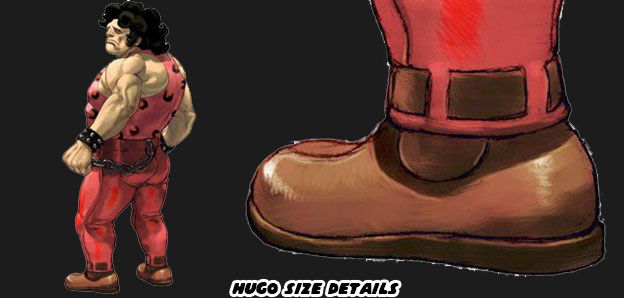
The new details that Capcom placed on the character were actually enhancing a few elements of his original look. Most Street Fighter characters wore gloves or taped up hands. Hugo was given a studded wrist guard to make his arms look less bare. The chain on his belt became much thicker and more industrial. It now looked more like a heavy duty towing chain, or anchor chain. The most overlooked details were his pants and boots. Hugo was not only tall but he was very heavy. His pants and shoes were actually two large pairs that were sewn together so they could fit him. The cuffs on his pants had belt loops and a belt to highlight that his ankles were as thick as most people's waists. His boots were split down the middle because they were a left and right pair combined to fit each foot. As with all of the great character designs, Hugo's costume told a story.
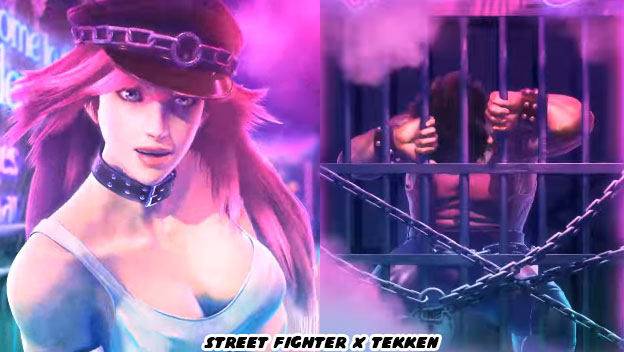
Although Hugo was supposed to be in the original Street Fighter III: New Generation (1997) his sprite wasn't ready until Street Fighter III: Giant Attack later that year. After the events of Street Fighter Zero/Alpha he had accomplished his goals of being a top draw on the wrestling circuit and leaving behind the Mad Gear persona. He achieved a number of championships as a pro wrestler during the events of Street Fighter III: Third Strike in 1999 and Final Fight Revenge. The character had greatly evolved since his debut in 1989 but when a new development team took over at Capcom things changed. When Hugo reappeared in Street Fighter X Tekken (2012) and Ultra Street Fighter IV (2014) he had mentally regressed. The new developers made a conscious decision to dumb him down considerably. Poison had done most of the talking for Hugo but at the same time he could still form his own ideas and opinions in the series. Almost overnight he was turned into a bumbling idiot, like Abigail, and that was a shame. Being a dumb brute was never part of their original designs.
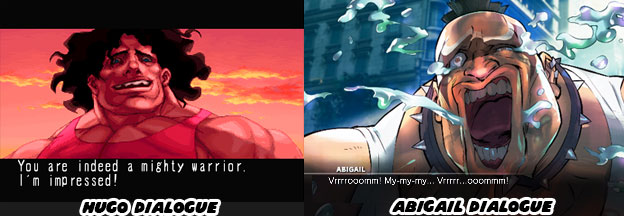
The people working on Street Fighter IV and V did not always preserve the character's original designs while updating their look. In some cases they haphazardly slapped together elements that had nothing to do with the fighter. Just look at the changes they made to the character Birdie. Compare the newer costume details placed on Hugo with those placed on Abigail. To let audiences know he was a punk rather than a wrestler they gave him a spiked collar (he originally had a chain around his neck). To show off his size they put truck tires around his biceps. Then hung car tires from his belt and gave him rings made out of small tires. They even printed tire marks on his pants, as if someone tried to run him over. Stealing a page out of Hugo's design they put a belt around his ankles. None of these things were part of Abigail's original design, none of these things were functional in battle and none of these things had the same subtlety of the other Street Fighter costume designs. Remember that Abigail wasn't always a moron. He was a fighter, and he had a temper, but he wasn't an idiot. He was very high up in the chain of command, only Rolento outranked him in Metro City's Mad Gear organization. But you know... tires!
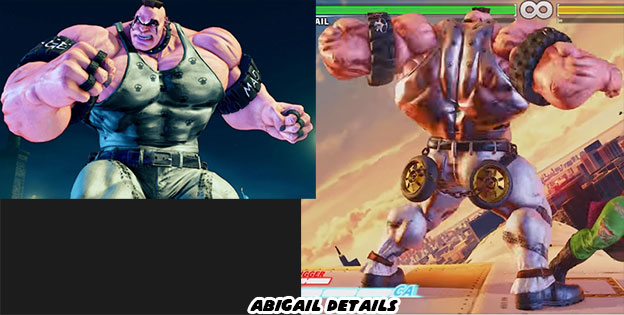
Another major difference between Hugo and Abigail in Street Fighter was seen with their inclusion. Abigail was a huge 3D model that was put in Street Fighter V as a spectacle. He took up so much space on the screen he was hard to ignore. His mass offset the scale of the rest of the cast, including Zangief. But Hugo was presented with more forethought in Street Fighter III, he didn't detract from the rest of the lineup. In Final Fight he battled while standing perfectly straight. This made him appear much larger than his opponents, which he clearly was, but it wasn't practical in a fight. He didn't have the flexibility or range of motion of his opponents. Guy was way more agile and even Mike Haggar could run circles around him. In SF III he was only shown a few times standing straight up, these were in some introduction poses and in the ending screen.
When the match started in Street Fighter III he actually squatted down and got into a sort of grappling pose. He lacked the techniques of veteran wrestlers but it showed that he had gotten much better at fighting since his Final Fight days. Hugo was still a little bit clumsy in Street Fighter III. Audiences could tell this in his animations. He shifted his weight awkwardly as he advanced. His steps were heavy and flat-footed. He didn’t move on the balls of his feet like a pro fighter would. He relied on power rather than technique. If he had the experience of somebody like Zangief or Darun Mister then he would have dominated the Street Fighter tournament. But since he didn’t there were ways for smaller and faster opponents to get the best of him. When he wasn’t fighting the developers liked to remind audiences of how awe-inspiring the giant was.
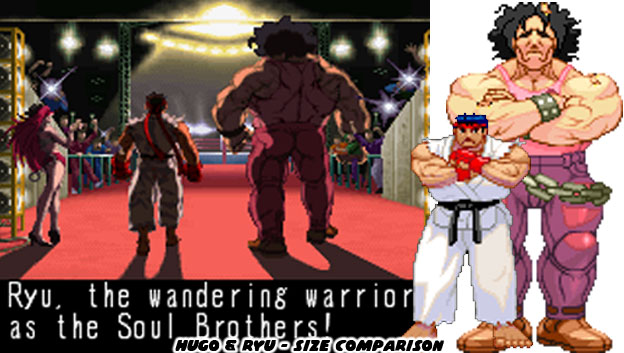
When Hugo stood straight up the top of his head almost touched the top of the screen, none of the other characters were even remotely this tall. Audiences could tell the character was big but they didn’t realize how big until they saw his game ending. In SFIII Giant Attack he had four alternate endings. In each one he was partnered up with a different opponent; Ryu, Elena, Necro and even the boss character Gill. Each tag team even had a unique nickname. For example Hugo and Elena made up Beauty and the Beast, whereas Hugo and Ryu made up the Soul Brothers. When the characters stood side-by-side it appeared as if Hugo were twice as tall and four times as heavy as his partners. His back was as broad as a double door and quite muscular. The stylized art helped sell the incredible scale of the figures while still keeping them consistent with the universe. This was the benefit of two-dimensional art. The designers could play with the proportions of the characters without losing the sense of realism. It was a trick that they picked up from manga and animé.
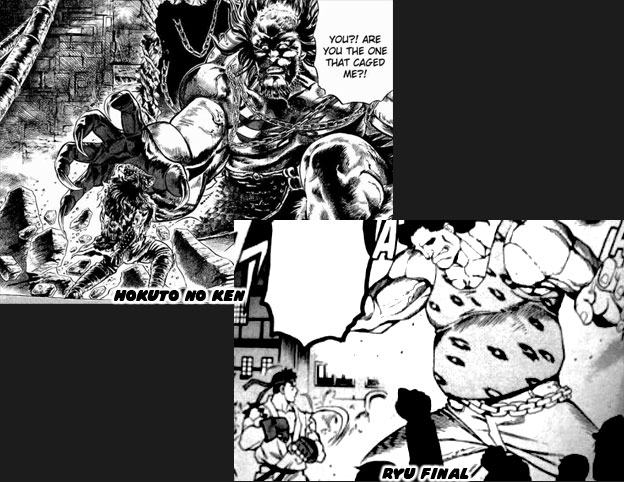
Tetsuo Hara introduced a number of unique manga rules in the Hokuto No Ken / Fist of the North Star series. Something he showed artists was that the scale of a character did not have to be consistent as long as it served the story. In the post-apocalyptic series Kenshiro often ran into roving gangs filled with giants. The scale of these villains was flexible. In some panels the bad guys looked like they were 10-feet tall, then a page later they appeared as if they were 30-feet tall. Mr. Hara would jump back and fourth between the different sizes depending on what he was trying to convey. In many instances he would highlight just one physical feature. There would be a close-up of a giant head behind Kenshiro so that it looked like he could bite the hero in half. Then in another panel it might be the hands of the giant engulfing the main character.
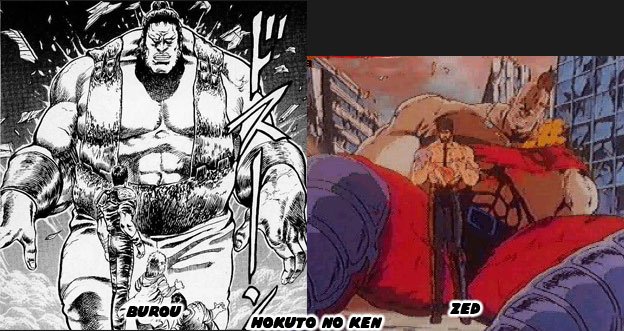
Often times when Kenshiro beat the giant the scene would be drawn from a distance showing that the bad guy wasn’t really the size of King Kong. These visual tricks made the odds seem greater for the hero of the story. Masahiko Nakahira wrote and drew a number of Capcom’s greatest Street Fighter stories in Japan. He was clearly aware of how influential Tetsuo Hara was to the development of Street Fighter II and III. In the Ryu Final manga he used many of the same techniques when featuring Hugo. In some panels he appeared to be several stories tall, capable of stepping over buildings. Then in other panels he seemed closer to his in-game size. Mr. Nakahira wanted to show how easily a giant could manhandle Ryu by messing around with the scale of the character. The thing that saved Ryu was his superior techniques. His relentless training could overpower any opponent, especially since Hugo lacked discipline.
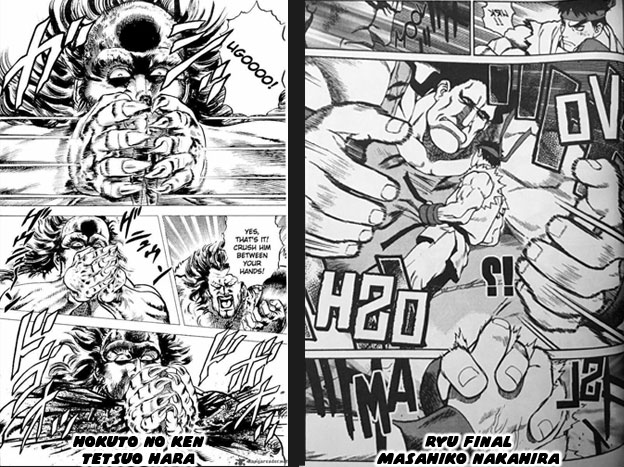
The Street Fighter games could never take the same artistic liberties that Mr. Hara and Mr. Nakahira used. Audiences would be furious if characters changed size in between rounds. The distorted scale of hands and feet during special attacks made Street Fighter EX and Final Fight Revenge seem awkward. But that did not stop the designers at Capcom from pushing the envelope with massive characters. The company created a library of giants through the ‘90s. The studio learned that they could create bosses with different body shapes. Yes the majority were hyper-muscular but take a closer look at them. Some had a broad torso, they were as wide as they were tall. Others stood up straight or were hunched over masking their true size. The majority of these people appeared in the Final Fight series. If you look at the size of the heroes and villains you’ll notice that they didn’t always match up. Mike Haggar for example was the tallest and strongest of the good guys in the Final Fight trilogy. He stood 6’ 6” and weighed about 233 lbs. In Final Fight 2 just about every boss was larger than him even though they were listed as being smaller in the official material.
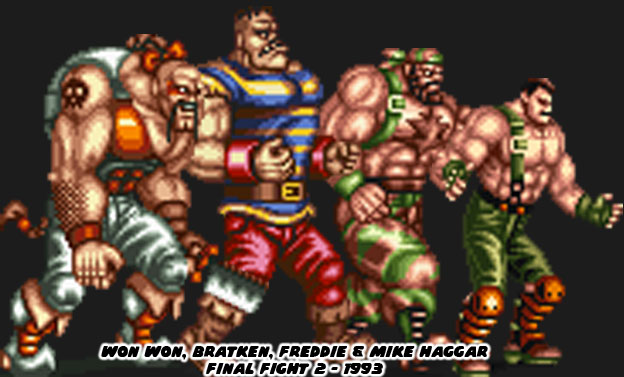
Freddie for example possibly had the broadest chest and thickest torso of any Mad Gear boss. This mercenary stood 6’ 4” and weighed 408 lbs. but his sprite was almost a head taller than Mike. Then there was Bratken, the Mad Gear boss that looked like Frankenstein’s monster. He was one of the largest sprites in the game but according to cannon he was 6’ 7” and 434 lbs. One inch of difference between he and Haggar meant a lot to Capcom of Japan. Then there was Won Won. Another of Mad Gear’s tallest bosses was 7’ 4” and an astonishing 450 lbs. Yet he was so muscular he couldn’t stand up straight, similar to Abubo in Rage of the Dragons. So his sprite was actually a little shorter than Bratken. Audiences could tell that the curve in his spine robbed him of his true size. Freddie was a tactical fighter whereas Bratken was a reckless brawler, locked away until he was needed. Won Won ran the streets of Hong Kong and chopped those who opposed Mad Gear in half with his cleaver. None of the bosses were ever presented as being stupid. There was too much at stake for betraying the gang. You couldn’t be stupid and be a boss at the same time.
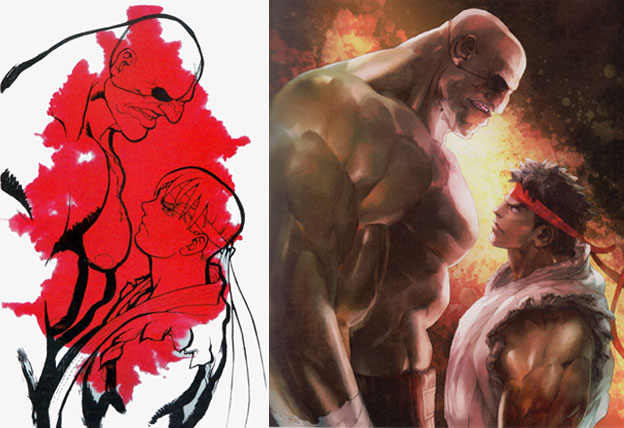
From a design standpoint making someone gigantic worked best when used on the bad guys. From a storytelling perspective it also made sense. Audiences rooted for the underdog. It was hard to make someone like Abigail the main hero in Final Fight because he could steamroll his opponents. This rule worked especially well in the Street Fighter series. Just look at how intimidating Sagat was by design. A seven-foot, dark-skinned, bald, eyepatch-wearing, Muay Thai monster. People couldn’t help but cheer for the tiny Ryu. It took a change in designers to turn things around. Tetsuo Hara worked with Capcom on a couple of projects. He showed the studio that a good guy could also be gigantic. Hara designed the cast for the Muscle Bomber / Saturday Night Slam Masters series. Mr. Hara was a huge wrestling fan, he knew the history of the sport and major players in the USA as well as Japan. He also knew that the Street Fighter characters were more than average fighters, they needed special moves and abilities. So he created a large group inspired by real world wrestlers but each with a unique back story and collection of special attacks. These people would become the backbone of Capcom’s wrestling universe.
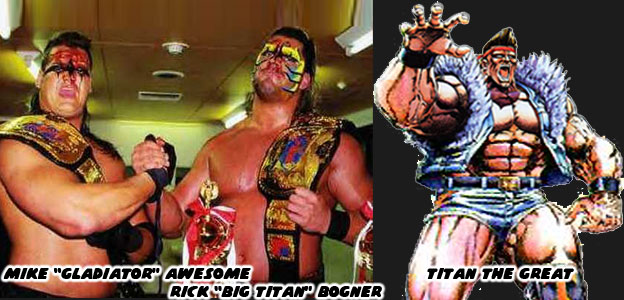
The tallest wrestler in the series turned out to be a good guy. Titan the Great aka Titanic Tim stood 7’ 9” and weighed 432 lbs. He was the third tallest character in the Street Fighter universe. But of those three he was the one with the most wrestling experience. The real world inspiration for the character were the 6' 6" Rick Bogner aka the Big Titan and 6' 5" Mike Awesome aka the Gladiator. The duo ran roughshod over the wrestlers in Japan during the early '90s. Titan the Great was an amalgamation of these two monsters. He did not have solely power moves in his arsenal but was a well rounded striker and grappler as well. He was agile despite his size. This was necessary when facing opponents that were blindingly quick. Titan was a British native and would sometimes team up with UK underground fighting legend Birdie. The two seven-footers were known as the 500 Million Trillion Powers.
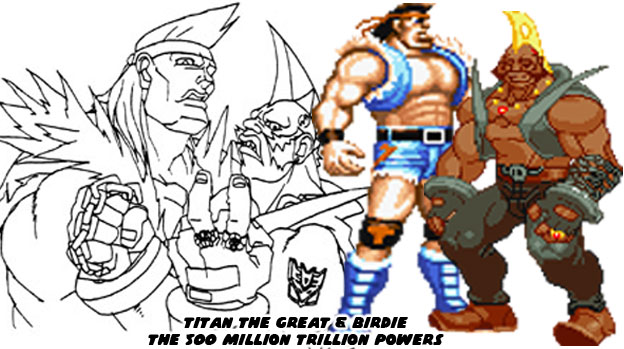
Whether good or bad the giants deserved to be in the Street Fighter universe. With that said I was not a fan of the direction of the current Street Fighter series. I have said it before and will continue to say it. The silly mannerisms of certain characters, the constant breaking of the 4th wall during super attacks did not really make sense and detracted from the cast. Think about how absurd each of Hakan’s super attacks appeared on screen in Street Fighter IV. The opponent would be squished between his thighs and then shoot off into an invisible barrier. These invisible barriers also showed up in Abigail’s special as well. He could suspend his opponent in the air and then use them like a punching bag. Honestly, an opponent just floated at the top of the screen, defying gravity like some sort of Warner Bros. cartoon character. Then there was the absurd notion that Abigail couldn’t talk but instead made car noises like an infant that had lost his toy. All of these silly elements betrayed the designs of the earlier Street Fighter and Final Fight games. They simply weren’t a part of the legacy. Capcom used to know how to create fantastic giants, the template was there but they seemed to ignore it after 1999.
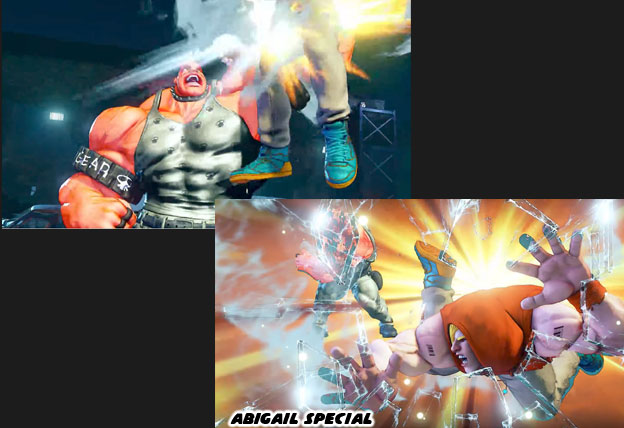
The goofy antics were all relatively new to the franchise. When Yoshinori Ono took on production duties they seemed to be part of his idea of what Street Fighter should be about. While nostalgia for the older characters is still in my heart I’m also afraid of what would happen if the studio decided to add any more legacy characters. I’d be embarrassed to see what they would do with the Muscle Bomber cast or any other fighter they had previously done. Giants in the Street Fighter universe should be feared and respected, as the majority were boss characters. Maybe someday the studio will remember that but I’m not holding my breath. I hope you have enjoyed this series, please leave a question or comment and I'll try to get back to you. As always if you enjoyed this blog and would like to sponsor me please visit my Patreon page and consider donating each month, even as little as $1 would help make better blogs and even podcasts!

No comments:
Post a Comment